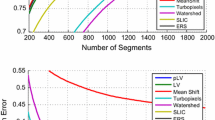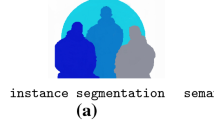Abstract
We propose an adaptive procedure for segmenting images by merging of homogeneous regions. The algorithm is based on sharp concentration inequalities and is tailored to avoid over- and under-merging by controlling simultaneously the type I and II errors in the associated statistical testing problem.
Access this chapter
Tax calculation will be finalised at checkout
Purchases are for personal use only
Preview
Unable to display preview. Download preview PDF.
Similar content being viewed by others
References
Pavlidis, T.: Segmentation of pictures and maps through functional approximation. Computer Graphics and Image Process 1, 360–372 (1972)
Zucker, S.W.: Survey: Region growing: Childhood and adolescence. Computer Vision, Graphics, and Image Processing 5, 382–399 (1976)
Forsyth, D.A., Ponce, J.: Computer Vision: A Modern Approach. Prentice-Hall, Englewood Cliffs (2003)
Monga, O.: An optimal region growing algorithm for image segmentation. International Journal of Pattern Recognition and Artificial Intelligence 1, 351–375 (1987)
Nock, R.: Fast and reliable color region merging inspired by decision tree pruning. In: IEEE Computer Society Conference on Computer Vision and Pattern Recognition (CVPR 2001), vol. 1, pp. I–271–I–276 (2001)
Fiorio, C., Nock, R.: Image segmentation using a generic, fast and non-parametric approach. In: 10th IEEE International Conference on Tools with Artificial Intelligence, Taipe, Taiwan, R.O.C, pp. 450–458. IEEE Computer Society, Los Alamitos (1998)
Fiorio, C., Nock, R.: A concentration-based adaptive approach to region merging of optimal time and space complexities. In: British Machine Vision Conference, Bristol, England, vol. 2, pp. 775–784 (2000)
Nock, R., Nielsen, F.: Statistical region merging. IEEE Trans. Pattern Anal. Mach. Intell. 26, 1452–1458 (2004)
Lehmann, E.L.: Testing statistical hypotheses, 2nd edn. Wiley Series in Probability and Mathematical Statistics: Probability and Mathematical Statistics. John Wiley & Sons, New York (1986)
Nock, R., Nielsen, F.: Semi-supervised statistical region refinement for color image segmentation. Pattern Recognition: Image Understanding for Photographs 38, 835–846 (2005)
Demaine, E.D., Emanuel, D., Fiat, A., Immorlica, N.: Correlation clustering in general weighted graphs; approximation and online algorithms. Theoretical Computer Science 361, 172–187 (2006)
Fiorio, C., Nock, R.: Sorted region merging to maximize test reliability. In: International Conference on Image Processing, Vancouver, Canada, vol. 01, pp. 808–811. IEEE, Los Alamitos (2000)
Mc Diarmid, C.: Concentration for independent permutations. Comb. Probab. Comput. 11, 163–178 (2002)
Hoeffding, W.: Probability inequalitites for sums of bounded random variables. Journal of American Statistical Association 58, 13–30 (1963)
Bennett, G.: Probability inequalities for the sum of independent random variables. Journal of American Statistical Association 57, 33–45 (1962)
Bernstein, S.: On a modification of chebyshev’s inequality and of the error formula of laplace. Ann. Sci. Inst. Sav. Ukraine, Sect. Math. 1 (1924)
Ledoux, M., Talagrand, M.: Probability in banach spaces. isoperimetry and processes. Ergebnisse der Mathematik und ihrer Grenzgebiete 3, xii+480 (1991)
Mc Diarmid, C.: Concentration. In: Habib, D.M., Ramirez-Alfonsin, R. (eds.) Probabilistic Methods for Algorithmic Discrete Mathematics, New-York, pp. 195–248. Springer, Heidelberg (1998)
Fiorio, C., Gustedt, J.: Two linear time Union-Find strategies for image processing. Theoretical Computer Science 154, 165–181 (1996)
Tarjan, R.E.: Efficiency of a good but not linear set union algorithm. J. of the Association for Computing Machinery 22, 215–225 (1975)
Author information
Authors and Affiliations
Editor information
Editors and Affiliations
Rights and permissions
Copyright information
© 2010 Springer-Verlag Berlin Heidelberg
About this paper
Cite this paper
Fiorio, C., Mas, A. (2010). A Sharp Concentration-Based Adaptive Segmentation Algorithm. In: Bebis, G., et al. Advances in Visual Computing. ISVC 2010. Lecture Notes in Computer Science, vol 6454. Springer, Berlin, Heidelberg. https://doi.org/10.1007/978-3-642-17274-8_9
Download citation
DOI: https://doi.org/10.1007/978-3-642-17274-8_9
Publisher Name: Springer, Berlin, Heidelberg
Print ISBN: 978-3-642-17273-1
Online ISBN: 978-3-642-17274-8
eBook Packages: Computer ScienceComputer Science (R0)




